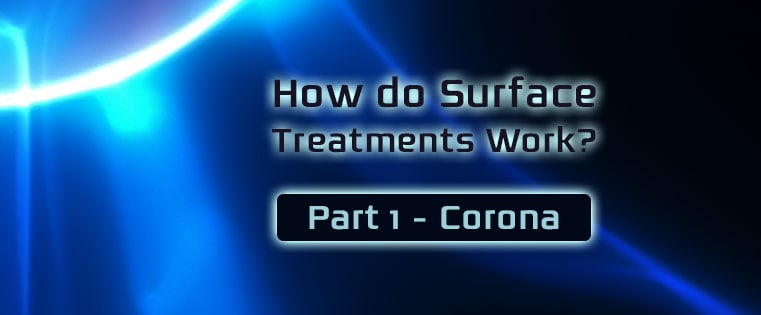
It’s a back-to-basics question, but one that we are asked often. Surface treatments are generally separated into two categories: atmospheric and low-pressure (or vacuum). Both use energy to ionize gas and are very effective at altering the surface properties of materials. Both can also help you increase your manufacturing yield. Today we spotlight corona treatment:
Corona surface treatments work by forcing a gas (usually air) between two high-powered electrodes at a high rate of speed. As the air passes through the electrical discharge, it becomes ionized and, in the presence of ambient oxygen, forms chemically functional groups on the surface of a substrate. The functional groups that result from the process increase the surface energy on polymers and other materials.
Corona treatments (or atmospheric treatments) use standard electrical power, but have limited controls, such as the distance the material is held from the electrical discharge, and the speed at which the material passes through the active plasma. Corona is an excellent treatment solution for common plastic films, such as those used in packaging. Review the top 4 questions to ask when sourcing a surface treatment partner.
Advantages of Corona Surface treatment:
Corona treatments can treat large substrates very rapidly, and are effective at making many commodity-grade polymers wettable to facilitate the application of adhesives, paints, inks and tape.
Considerations of Corona Surface treatment:
- Treatment lifespan
- Treatment lifetime can be relatively short; minutes, hours or days depending on the substrate and the effectiveness of the treatment. However, this is a non-issue in applications where adhesives or paints are applied immediately after the treatment.
- Heat distortion
- Since the electrical discharge is quite hot, it’s critical to calibrate the speed at which the substrate passes through the plasma region. Also look at the distance between the substrate and the discharge. In cases where the speed is too slow or the distance too short, thermal distortion is likely to occur.
- Uniform Coverage
- Since only the area of the substrate that is passed through the plasma region is treated, surface areas may not be treated evenly. This is especially true when working with complicated geometries.
- Ozone levels
- Corona surface treatments generate high levels of ozone, so proper ventilation precautions must be taken.
Share your experience with corona treatment in the comments!









